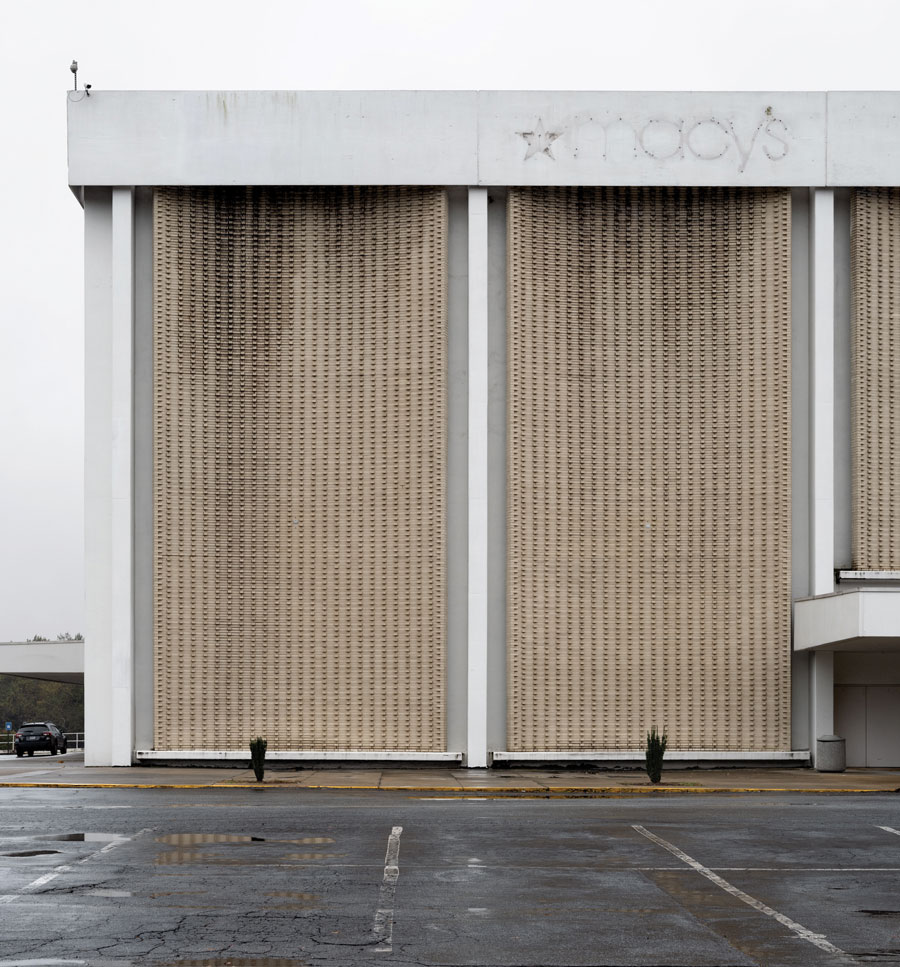
Photograph by Joshua Dudley Greer
Sheets of brown kraft paper cover the windows of the former Macy’s at Greenbriar Mall as I walk down the main concourse on a weekday evening. A few dozen shoppers are quietly strolling the maroon-and-gray tiled floor from the shuttered department store to the far side, where Burlington Coat Factory closed in 2019.
No more than two customers browse any of the remaining stores I pass, from streetwear retailers like Authentiks to African art shop Tinga Tinga. The overhead lights seem dimmer than they should be. Even the gold chains and watches at Greenbriar’s many jewelry kiosks don’t seem interested in shining brightly enough to attract attention.
Designed by famed Atlanta architect John Portman’s firm, Greenbriar Center arrived in 1965 as one of the city’s first enclosed, air-conditioned malls. It was a pioneer of mall food courts, welcoming the world’s first Chick-Fil-A in 1967. Back then, there were projections of population increases and economic growth in the surrounding Southwest Atlanta community. On opening day, Harold Brockey, then president of Rich’s—one of Greenbriar’s first anchor stores—reportedly told the audience, “There is no limit to the future of this area.”
That optimism, like the area’s white population, faded over the next decades. Still, some 25 years later, the complex was such a cultural hot spot that a teenaged Jermaine Dupri discovered two kids here who would become Kris Kross, one of Atlanta’s first world-famous rap acts.
Without its largest tenants, Greenbriar now feels like a ghost of Christmas past—reflecting a nationwide trend. Some 40 percent of U.S. department stores have shuttered since 2016, according to Green Street Advisors, which also predicts about half of the remaining mall locations will close in the next few years. Online shopping—accelerated by the pandemic—and changing consumer tastes have hurt both department stores and smaller chains. The question is, does anybody care?
During my recent visit, I unexpectedly ran into Mohamed Balla, Atlanta’s CFO, who was there buying sneakers. Balla clearly isn’t the only person who sees Greenbriar as a sneakerhead paradise. Foot Locker, Footaction, and five other shops selling casual footwear have effectively become Greenbriar’s new anchors.
Balla, who lives nearby in South Fulton, said he’d love to see malls like Greenbriar turn abandoned spaces into centers for shared community resources. “There could be an ideal space for public-private partnerships to transform some of these underutilized assets for community benefits, such as libraries and recreational facilities,” he said.
His idea isn’t far from what Jagdish N. Sheth, professor at Emory’s Goizueta Business School and a global expert on consumer behavior, predicts for the future of malls and shopping centers. Sheth lives near Decatur and has been a frequent shopper at the Toco Hills Shopping Center and, formerly, at North DeKalb Mall before its October 2020 closure. Through personal observation and research, he’s settled on three likely models, none of which rely on moving merchandise.
First, he says, there will be “services malls,” where consumers can find restaurants, movie theaters, and professional offices. An example would be Camp Creek Marketplace, an area with retailers like Target and BJ’s Wholesale Club, but also smaller stores, an AMC Theatre, and services like H&R Block, One Main Financial, a chiropractic office, and even a police precinct. Sheth cautions that such malls must be careful not to get overloaded with restaurants, which can sometimes afford to pay higher rents. That’s happening at Toco Hills, he says, where stores like OfficeMax and RadioShack are being replaced by pubs and eateries. A wide variety of offerings is what keeps these spaces vital.
Next would be “entertainment malls,” featuring not just cinemas and restaurants but hotels, amphitheaters, and performance venues for live shows, such as the Eastern at Atlanta Dairies in Reynoldstown. Franchises like Topgolf and Andretti Indoor Karting & Games are also eager to take over languishing real estate with ample parking.
A third option is turning vacant property into multipurpose housing developments, which Sheth believes is likely the future for North DeKalb Mall. “The land is more valuable than the infrastructure,” he says. Finally, he adds one wild card: “Amazon is going to buy some of those malls as fulfillment centers.”
Ellen Dunham-Jones, director of Georgia Tech’s Urban Design master’s degree program and coauthor of Case Studies in Retrofitting Suburbia, released earlier this year, stresses that any reimagining should also address environmental concerns because, in many cases, today’s malls never should have been constructed on the land they occupy.
“We built a lot of malls on wetlands and on top of creeks before the Clean Water Act. Now, with climate change and more severe storms, there are a lot of reasons to de-pave those parking lots and, in some way or another, regreen them,” she says.
Dunham-Jones says the creation of Historic Fourth Ward Park is a great example of smart, sustainable, and economically sensible planning. She says developer Jamestown demanded a solution to City Hall East’s flooding problems before it would purchase the building. That led to what she calls a “beautifully designed, open-air stormwater retention pond” we know as Historic Fourth Ward Park. So, we can thank a drainage fix for what’s arguably the most significant mixed-use retail and residential development in recent Atlanta history: Ponce City Market.
As I exit the doors near Macy’s and walk to my car, I can’t help thinking the lack of mobility is a major block to Greenbriar’s potential revitalization—although there are hopes for possible light rail transit (LRT) or bus rapid transit (BRT) along the Campbellton Corridor, a major but overlooked artery that links Southwest Atlanta to downtown.
Debbie Frank, director of transit-oriented development at MARTA, confirms transit options for the area are being studied. She adds, “There’s a tremendous opportunity to see the redevelopment of malls in a way that is more urban in character than what we’ve grown accustomed to since the ’70s.” For Greenbriar, she’s heard rumors of a potential sale and possible workforce-training component. “Malls were created as this kind of single use,” she explains. “I think we’re seeing the reimagination of the opportunity that exists in these 100-plus–acre [sites], because of their vicinity not only to interstate access or road access but also the opportunity that exists as it relates to the communities in which they’re situated.” Rather than just retail, she suggests they could offer hotels, care facilities, satellite college campuses, libraries, community centers, and other government offerings. “Malls have the ability to really transform into mixed-use communities that are providing offerings for everyone.”
Although most malls are served by bus systems, LRT and BRT could make centers more accessible, she notes. “You have to be really excited about the terminus of Greenbriar Mall and all the redevelopment opportunities that will exist.”
Such potential already exists at the Mall West End, which has a MARTA rail station within walking distance. And Gwinnett Place Mall has a proposed BRT route. There’s even hope for Cumberland, which is soon to be redeveloped with nearby offices and apartments. The Cobb County complex is next to the CCT Cumberland Transfer Center, though it isn’t likely to see rail anytime soon.
As I drive the ridiculously short distance from Greenbriar to my house in East Point, I wonder if there are more folks in city government like Balla who can imagine a Greenbriar Mall worth saving for the sake of SWATS (“Southwest Atlanta, Too Strong”), in addition to private financial interests. Or if some civic-minded developer—perhaps, say, a highly successful Atlanta-based restaurant chain interested in preserving its first-ever location?—wants to give the city the gift of a renewed and reimagined plan for Greenbriar this holiday season.
Changes coming to metro-Atlanta malls
Northlake Mall: Emory Healthcare recently took over a 240,000-square-foot former Sears space in the 50-year-old Tucker center, spurring renewed interest in its potential as a center for office, residential, retail, and restaurant projects.
North DeKalb Mall: The 77-acre property has been the site of TV and film projects since its main section closed in 2020. It’s had a few false starts involving a potential Costco before real estate developer Edens purchased it in September with plans for a mixed-use future.
The Mall West End: This Southwest Atlanta shopping center was purchased by a New York–based developer in the spring and will reportedly be demolished soon for new condos, apartments, stores, and offices, after plans for a transit-connected “mini-city” put forth by BeltLine creator Ryan Gravel and venture capitalist Donray Von fell through.
Gwinnett Place: Gwinnett County purchased 30-plus acres of this complex, which opened in 1984 and fell into a dystopian existence in recent years; plans now include a mixed-use plot with pedestrian- and bicycle-friendly greenspace and possibly bus rapid transit.
North Point Mall: Covid-related delays on a planned open-air revamp of the Alpharetta mall caused an ownership change in early 2021. Now, with Trademark Property Management taking the lead, the new vision includes more than 600 multifamily units, four- to six-story office buildings, a luxury hotel, a medical office, and walkable trails and paths.
This article appears in our December 2021 issue.








![The North Carolina Museum of Natural Sciences’ newest exhibit is a [pre]historic first](https://cdn2.atlantamagazine.com/wp-content/uploads/sites/4/2024/04/DD-3-100x70.jpg)




